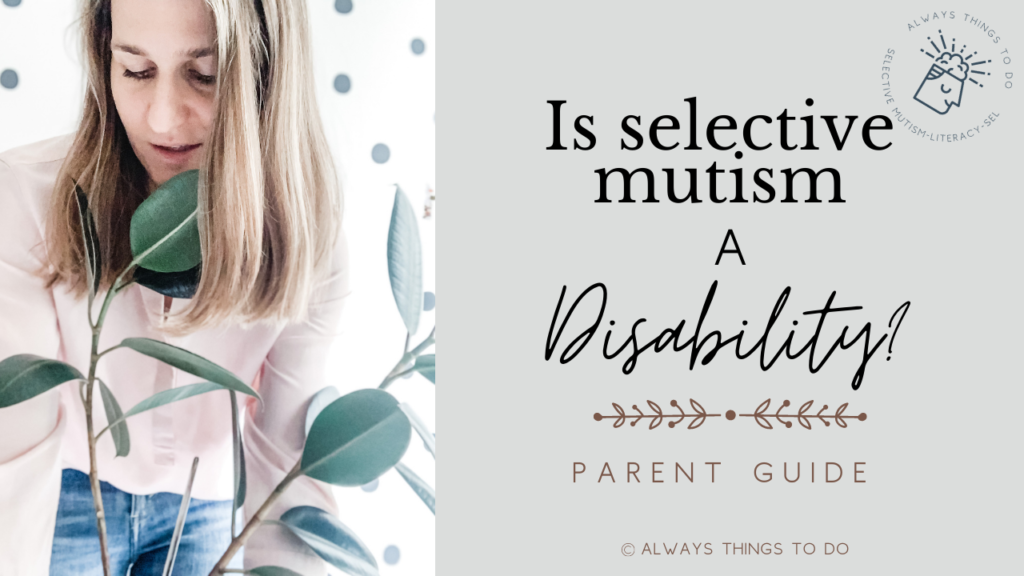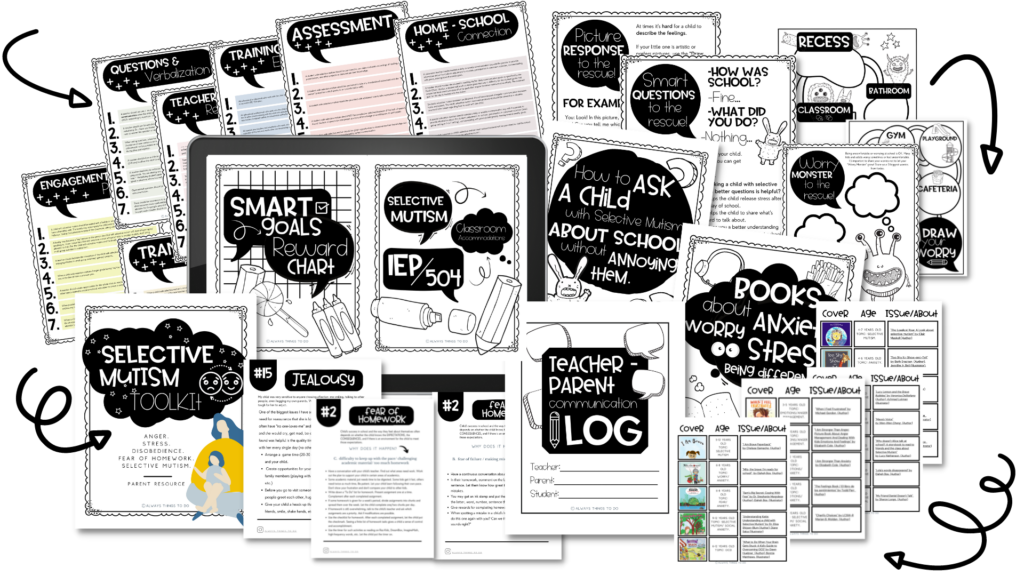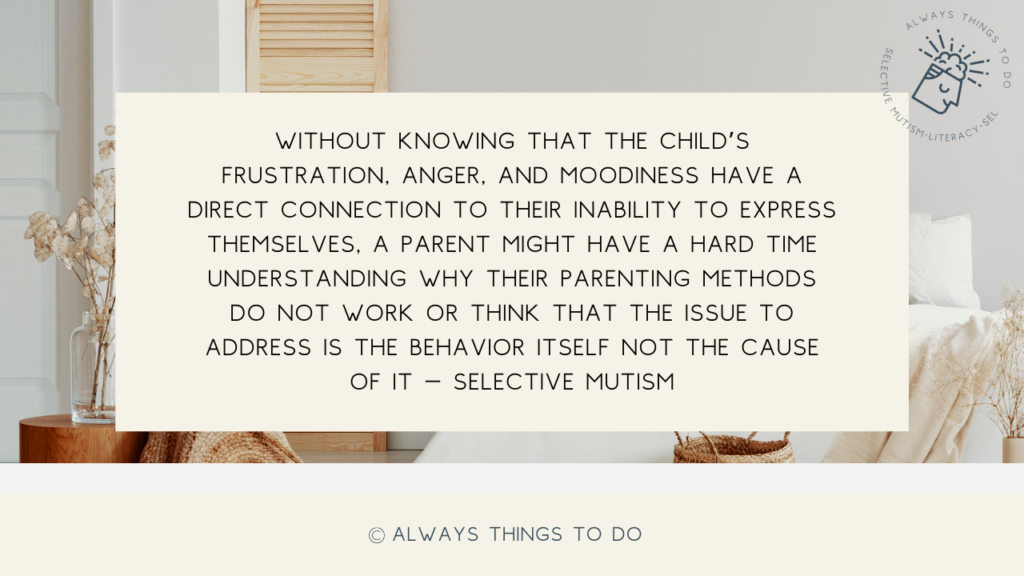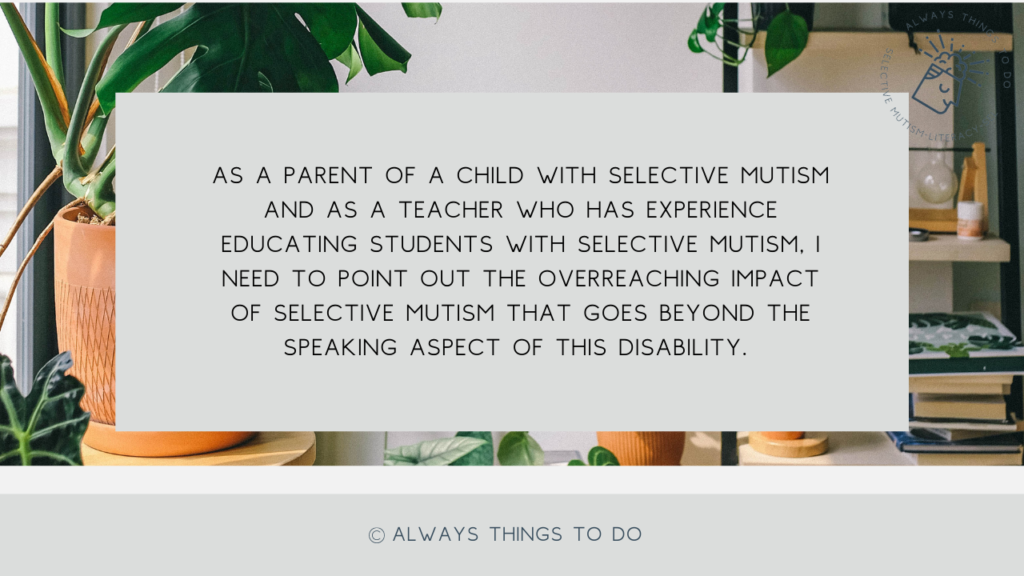Is Selective Mutism a Disability?

This post will talk about:
- is selective mutism a disability?
- how a child with selective mutism affected emotionally and academically,
- IEP / 504 plan for selective mutism at school,
- tools and resources for selective mutism.
According to CDC, disability is “any condition of the body or mind (impairment) that makes it more difficult for the person with the condition to do certain activities (activity limitation) and interact with the world around them (participation restrictions).”
Among the disabilities, there are categories that identify the area affected by the disability, such as:
- vision
- movement
- thinking
- remembering
- learning
- communicating
- hearing
- mental health
- social relationships
Let’s look at the definition of selective mutism disorder to help identify the answer to the question of whether selective mutism is a disability.
Selective mutism is “a complex childhood anxiety disorder characterized by a child’s inability to speak and communicate effectively in select social settings, such as school. These children are able to speak and communicate in settings where they are comfortable, secure, and relaxed”, explains Dr. E. Shipon-Blum from Selective Mutism, Anxiety & Related Disorders Treatment Center.
Selective Mutism Association characterizes children affected by selective mutism as being able to”...understand language use and, although they have the physical and cognitive ability to speak, they demonstrate a persistent inability to speak in particular settings over a particular period of time due to anxiety. “
Highlighted in the definitions, such aspects as a child’s inability to speak and communicate place selective mutism disorder among disabilities.
If you talk to anyone who has been affected by selective mutism in childhood or adulthood or try to get a perspective from a parent of a child with selective mutism disability, you surely find out that selective mutism is NOT just about SPEAKING (better to say NOT SPEAKING).
Characterized by many nuances and the broad area of impact on a child’s functioning and well-being, selective mutism seems to “disable” a child in so many ways that addressing selective mutism also requires a complex approach of treatment and interventions.
The best support for a child with selective mutism at school can be provided through an IEP or a 504 plan. Read about selective mutism classroom accommodations in “Selective Mutism Classroom Accommodations: What You Need To Know About IEP and 504”.
Tools & Resources to Start Learning about Selective Mutism and Addressing the Initial Questions and Concerns.
- “What are the causes of selective mutism?” booklet
- “Diagnosis of selective mutism” booklet
- “Basic needs” booklet
- “Selective Mutism behavior tracker/reward chart: school edition” booklet
- “30 selective mutism symptoms and behaviors” booklet
- “Selective Mutism behavior tracker/reward chart” booklet
- “Selective mutism checklist” booklet
While dealing with the school about the issue of selective mutism may seem an overwhelming task, it’s good to start with some basic ideas that might help you wrap your head around the things that need to be taken care of. Check this Back-To-School Checklist, to learn about the essentials of transitioning to school with selective mutism.
Explore this Home-School Selective Mutism Parent Toolkit to find the must-have resources for:
- IEP / 504 Selective Mutism Accommodations
- Teacher-Parent Daily Communication Log Templates
- Selective Mutism 15 common struggles Toolkit
- Smart Goals Reward Chart
- 55 Books to read to your child about Selective Mutism, Anxiety, Worry
- How to ask a child about school without annoying them

What is the Impact of the Selective Mutism Disability on a Child?
As a parent of a child with selective mutism and as a teacher who had students with selective mutism, I need to point out the overreaching impact of selective mutism beyond the speaking aspect of this disability.
Among the areas also impacted by selective mutism disorder are:
- thinking
- remembering
- learning
- communicating
- hearing
- mental health
- social relationships
Selective Mutism Symptoms and Behaviors that Prevent a Child From Functioning Normally.

While each child with selective mutism has a unique profile of functioning and emotions, certain behaviors and symptoms are common to all children with selective mutism disability.
Ruth Perednick succinctly explains that “one thing is almost always the case with a child who is not speaking in kindergarten or school: a child with selective mutism suffers. He cannot be himself – the more spontaneous, communicative child he is in other contexts” (Perednik, 2012)*
Some other selective mutism symptoms are:
1. Being uncomfortable to be introduced, teased, or criticized
2. Perfectionism (fear to make mistakes)
3. Embarrassment to eat in front of others
4. Defiance
5. Disobedience
6. Easily frustrated
7. Stubbornness
8. Inflexible
9. Moodiness
10. Bossiness
11. Assertiveness and domineering behavior at home
12. Mood swings
13. Awkward body language
14. Lack of eye contact when feeling anxious
15. Easily frustrated by school work
16. Stubbornness
17. Inflexible
18. Procrastination when doing homework
It is essential to know that most often a child’s with selective mutism displays behaviors and attitudes (such as stubbornness, inflexibility, moodiness, bossiness, assertiveness, domineering behavior at home, etc.) that come as a consequence of the “constant energy expenditure” (Perednik, 2012, p. 76 ) required to ensure no one encroaches their private space.
In other words, a “bottled up” child (not being able to express himself and interact socially and academically) often comes home and finally expresses his frustration through tantrums, crying, or any other behaviors a child with selective mutism tends to show.
When my daughter was diagnosed with selective mutism, I would often notice the tantrum-prone hours of the day were more and more regular.
After returning home from her Pre-K (and later when she was in kindergarten), my child would have mood swings, be stubborn, cry, hit, have tantrums.
Without knowing that the child’s frustration, anger, and moodiness has a direct connection to their inability to express themselves (in selective mutism), a parent might have a hard time understanding why their parenting methods do not work or think that the issues to address are behavior itself, not the cause of it – selective mutism.
Read this article about selective mutism causes to know more.
How Does Selective Mutism Impact a Child Academically?
The lack of verbal communication deprives a child with selective mutism of other essential experiences in the child’s development, such as social communication and academic learning.
When my child turned a 1-grader, her teacher often expressed concern about my daughter not doing well in writing or sound recognition.
As a mom and a teacher, I knew that I had to address my daughter’s anxiety condition for her academic skills to improve.
- In a school setting, during the day, children perform a variety of tasks and activities that build and develop their academic knowledge and skills: sing phonics songs, phonics chants, practice reading with a buddy or independently, reading aloud with a teacher.
- While working on their writing skills, children often have to talk to a peer or a partner about their stories and say the sentences aloud to themselves to formulate their thoughts.

Imagine a selective mutism child missing on all these activities since they do not talk in school. There surely be an impact on academic skills, which eventually can affect a child’s self-esteem and worthiness.
Having the right gut feeling then, when my daughter was a first-grader, I persevered in focusing on addressing her anxiety and emotional development first.
Since the home environment was less anxiety-provoking, I would spend some additional time working with my daughter on phonics, reading, and writing to keep her skills developing. I knew once her anxiety goes down, she will keep up with her academics.
Academic challenges that come naturally due to the lack of speaking in school, in my opinion, should not be of a massive alarm to a parent.
One important thing to remember is that academic struggles in school result from the child not fully participating in a learning process due to the lack of speaking (some children do not even whisper).
Solving the academic issues has to start with addressing anxiety first (as part of the selective mutism treatment) and using various strategies in a classroom for a teacher to boost child’s self-esteem and include a child in a classroom community:
-play ing child’s recording of speaking or reading a story;
-display child’s work that has nothing to do with speaking (drawing skills), etc.
How Does Selective Mutism Impact a Child Emotionally?
Finally, the most devastating impact of selective mutism disability is on child’s emotions.
Being a mom of a 4-year-old with selective mutism (she is seven now), I have come to learn that a child’s social and emotional development is the backbone of any success in life.
Since I learned about social-emotional development (link to my article) myself, I attribute a huge portion of success in my child’s treatment of selective mutism to addressing emotions:
- teaching feelings
- teaching how to talk about feelings
- teaching how emotions impact behavior
- teaching self-regulation
- teaching social awareness
- troubleshooting anger, moodiness, frustration
Addressing a child’s emotional development and well-being does not stop when the child leaves home. A school is a primary place where a teacher can use selective mutism intervention strategies and techniques to ensure a child is understood and supported in academic development.
Building self-esteem, a sense of belonging, and worthiness for a child with selective mutism is vital in tackling their anxiety.
IEP/ 504 Plan for Selective Mutism.
Read about selective mutism classroom accommodations in “Selective Mutism Classroom Accommodations: What You Need To Know About IEP and 504”. You will learn about:
- Why you need an IEP or 504 plan to give your child the best selective mutism classroom accommodations.
- Which plan (504 or IEP) is best for selective mutism classroom accommodations.
- What parents need to know about IEP and 504.
- How to make selective mutism classroom accommodations actionable.
The first step in treating selective mutism in a school setting is evaluating the child by the child’s study team to determine their eligibility for the special services. Prior to that, find a specialist who can diagnose your child for selective mutism.
A school usually comes on board with qualifying a child with selective mutism disability as eligible for services, and this is fantastic.
Before the child’s study team evaluated my child, I feared a special education setting due to my lack of proper knowledge about how beneficial special education services can be for a child with selective mutism.
I was also worried about labeling, prejudice, naming, stereotypes.
It’s all gone now, and let me bluntly tell you that kids do not give a crap about anyone being in a special education program.
Kids don’t label.
Kids don’t see differences.
Kids have a natural desire to be good and play.
Even at middle school and high school, I saw great camaraderie and support of classroom peers for any kids in special education services.
The best accommodations your child with selective mutism can get is through the IEP plan. Compared to the 504 plan, the IEP plan is more serious and can be very detailed, tailored precisely to your child’s needs.
Also, IEP provides 1-to-1 or small groups services with a special education teacher – a perfect setting for a child with selective mutism.
Remember, even if your child was refused an IEP and has a 504 plan, you still have the right to request a meeting with a school administrator and teacher and/or a school psychologist to give them information about working with your child.
The key takeaways:
-Selective mutism is a disability that can be addressed in a school setting through theIEP plan (or 504)
-Selective mutism impacts a child’s academic and social-emotional development.
Resource cited: *The Selective Mutism Treatment Guide: Manuals for Parents, Teachers, and Therapists: Still
Waters Run Deep / Ruth Perednik, Oaklands, 2012.
If you liked the information in this post, make sure you explore other posts about selective mutism:
- “What Is Selective Mutism?”
- “Selective Mutism: How To Beat Crisis, Screaming, and Fear.”
- Diagnosis of Selective Mutism: Simple Parent Guide and Steps to Take.
- What Are The Causes of Selective Mutism?
- How Do You Treat Selective Mutism?
- 70 Selective Mutsim Symptoms & 3 Diagnostic Criteria.
- Selective Mutism Myths: Most Common Concerns Addressed.
- Selective Mutism Classroom Accommodations: What You Need To Know About 504 and IEP.
Check out the expanding library of tools. Go to the selective mutism page and scroll to the bottom section, “Latest Projects.”
Connect with me on social media @alwaysthingstodo.




3 Comments
Pingback:
Pingback:
Pingback: